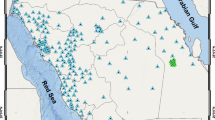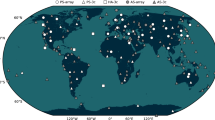Abstract
The detectability and reliability analysis for the local seismic network is performed employing by Bungum and Husebye technique. The events were relocated using standard computer codes for hypocentral locations. The detectability levels are estimated from the twenty-five years of recorded data in terms of 50%, 90% and 100% cumulative detectability thresholds, which were derived from frequency-magnitude distribution. From this analysis the 100% level of detectability of the network is M L=1.7 for events which occur within the network. The accuracy in hypocentral solutions of the network is investigated by considering the fixed real hypocenter within the network. The epicentral errors are found to be less than 4 km when the events occur within the network. Finally, the problems faced during continuous operation of the local network, which effects its detectability, are discussed.
Similar content being viewed by others
References
Bungum H, Husebye E S. 1974. Analysis of the operational capabilities for detection and location of seismic events at NORSAR [J]. Bull Seism Soc Amer, 64(3): 637–656.
Gansser A. 1964. Geology of the Himalayas [M]. London: Wiley Interscience, 289.
Gutenberg B, Richter C F. 1954. Seismicity of the Earth [M]. Princeton: Princeton University Press, 16–25.
Lahr J C. 1987. HYPOELLIPSE: A Computer Program for Determining Local Earthquake Hypocentral Parameters, Magnitude and First Motion Pattern [R]. USGS, Open File Report, 84-519.
Lee W H K, Lahr J C. 1975. HYPO71 (Revised): A Computer Program for Determining Hypocenter, Magnitude and First Motion Pattern of Local Earthquake [R]. USGS, Open File Report, 75-311.
Mahmood T, Qaisar M, Mubarak M A. 1992. Analysis of Completeness of the Earthquake Catalogue in the Chashma-Nilore Region [R]. MSSP Report No. 43/92, 1–17.
Mubarak M A, Ali I, Shah D, et al. 1977. A Description of the Chashma and the Nilore Microseismic Networks [R]. PINSTECH Report No. PINSTECH/MSSP-1/77, 1–16.
Richter C F. 1958. Elementary Seismology [M]. San Francisco: Freeman, 768.
Sacks I S, Rydelek P A. 1995. Earthquake quanta as an explanation for observed magnitudes and stress drops [J]. Bull Seism Soc Amer, 85(3): 808–813.
Siddiqui M R, Kazmi S A T. 1964. The geology of Thal Doab West Pakistan [J]. Bull Water and Soil Investigation Division, WAPDA, Pakistan, No. 7, 8–10.
Taylor D W A, Snoke J A, Sacks I S, et al. 1990. Non linear frequency-magnitude relationships for the Hokkaido Corner Japan [J]. Bull Seism Soc Amer, 80: 340–353.
Author information
Authors and Affiliations
About this article
Cite this article
Qaisar, M., Mahmood, T. & Khan, S.A. Detectability and reliability analysis of the local seismic network in Pakistan. Acta Seimol. Sin. 16, 59–66 (2003). https://doi.org/10.1007/s11589-003-0007-8
Received:
Revised:
Accepted:
Issue Date:
DOI: https://doi.org/10.1007/s11589-003-0007-8




